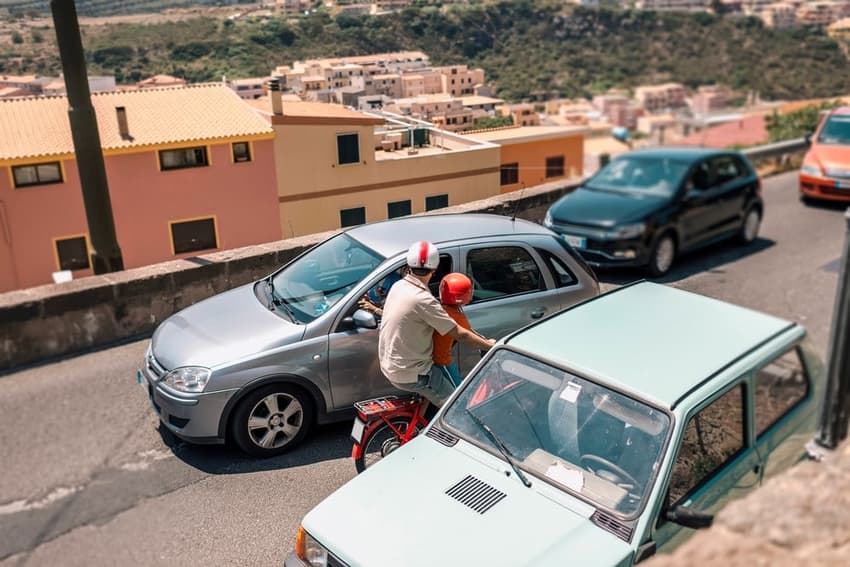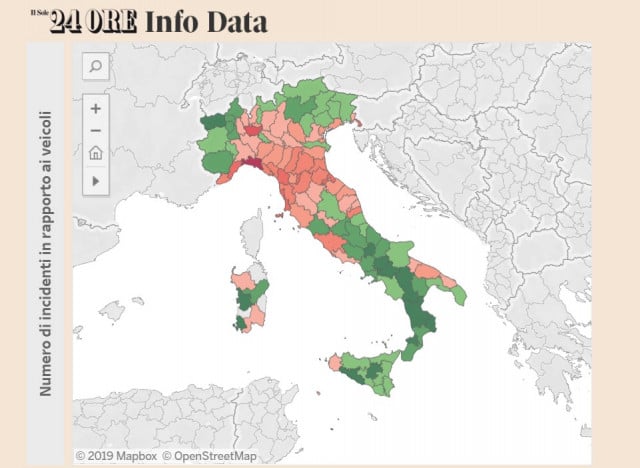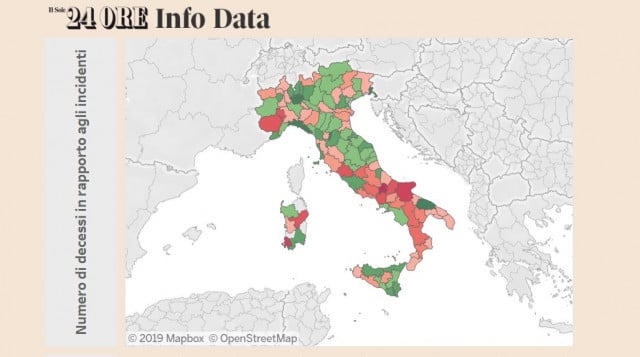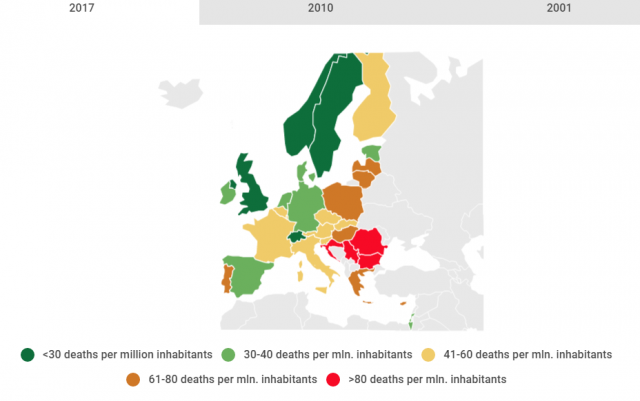Italian roads 'more dangerous in north than south': study

A new attempt to map road safety in Italy appears to show that roads in the south are actually safer. Could it be true?
Southern Italy is famed for many things, but safe and responsible driving is not one of them. Naples' famous tangenziale, or ring road, is well-known as one of the biggest accident blackspots in Italy.
So a new map based on road safety statistics across Italy raised a few eyebrows by appearing to show that the south of the country is actually a far safer place to drive than the north.
The latest road accident data from national statistics agency Istat was published in map form by Italian financial newspaper Il Sole 24 Ore.
Drivers in southern Italy have fewer accidents overall than those in the north, according to the most recent figures available, which date from 2017.

In fact, the data map created by the Italian newspaper is coloured almost completely green (indicating a lower rate of accidents) from Abruzzo down to Sicily.
Meanwhile, much of the north of the country is red - with the exception of most Alpine regions - appearing to show the opposite of what many people would expect.
According to the data, the most dangerous place to drive in Italy is the cty of Genoa.
The data showed that Genoa had 7.6 accidents per 1,000 vehicles on the road, on either two or four wheels.
it was followed by Milan, Savona, Rimini and Prato - all of which are in the north or centre-north of the country.

The safest area was judged to be the northern region of Aosta, with only 1.07 accidents per 1,000 vehicles. Agrigento in Sicily came next, followed by the southern regions of Avellino, Vibo Valentia and Benevento.
This data includes every type of road accident reported - from minor scrapes to deadly collisions.
When we look at the rate of fatal accidents, however, the figures paint a more familiar picture.

While overall accident rates may be higher in parts of the north, it would seem that the risk of getting into a serious accident is greater in southern Italy.
This is unlikely to come as a shock to anyone who has ever driven in Italy. But some of the regional data may be more surprising.
Rome, which has been ranked in other studies as one of the most dangerous places to drive in Europe, was not rated among Italy's worst this time.
While the capital had a fairly high number of accidents (4.62 per 1,000 vehicles) it was far from the highest in the Istat study, and the city's mortality rate was found to be relatively low.
And, despite its terrible road safety repution, it turns out that Naples is not actually the most dangerous place to drive in southern Italy.
READ ALSO:
-
-
-
The south's second city, Bari, is statistically more dangerous, with almost twice as many accidents reported - though it also had the lowest rate of fatal crashes in the south.
Naples too had a relatively low number of fatalities. The number of road deaths in nearby Isernia was more than triple that in Naples.
Overall, the figures show a slight decrease in accident rates across Italy on last year.
Accident rates in Italy peaked in 2002, before steadily declining after the introduction of new road safety laws in 2003 and then mostly levelling off, seeing little change in the past few years.

Overall, Italy still ranks poorly for road safety among other European member states.
Italy has one of the highest numbers of annual road traffic deaths in western Europe, at 55 deaths per million inhabitants in 2017, according to EU statistics. This was more than Spain, with 39.3, and far worse than northern European countries like Norway (20) and the UK (27.1).
 European statistics show the number of road deaths annually per country. Image: European Transport Safety Council
European statistics show the number of road deaths annually per country. Image: European Transport Safety Council
Comments
See Also
Southern Italy is famed for many things, but safe and responsible driving is not one of them. Naples' famous tangenziale, or ring road, is well-known as one of the biggest accident blackspots in Italy.
So a new map based on road safety statistics across Italy raised a few eyebrows by appearing to show that the south of the country is actually a far safer place to drive than the north.
The latest road accident data from national statistics agency Istat was published in map form by Italian financial newspaper Il Sole 24 Ore.
Drivers in southern Italy have fewer accidents overall than those in the north, according to the most recent figures available, which date from 2017.

In fact, the data map created by the Italian newspaper is coloured almost completely green (indicating a lower rate of accidents) from Abruzzo down to Sicily.
Meanwhile, much of the north of the country is red - with the exception of most Alpine regions - appearing to show the opposite of what many people would expect.
According to the data, the most dangerous place to drive in Italy is the cty of Genoa.
The data showed that Genoa had 7.6 accidents per 1,000 vehicles on the road, on either two or four wheels.
it was followed by Milan, Savona, Rimini and Prato - all of which are in the north or centre-north of the country.

The safest area was judged to be the northern region of Aosta, with only 1.07 accidents per 1,000 vehicles. Agrigento in Sicily came next, followed by the southern regions of Avellino, Vibo Valentia and Benevento.
This data includes every type of road accident reported - from minor scrapes to deadly collisions.
When we look at the rate of fatal accidents, however, the figures paint a more familiar picture.

While overall accident rates may be higher in parts of the north, it would seem that the risk of getting into a serious accident is greater in southern Italy.
This is unlikely to come as a shock to anyone who has ever driven in Italy. But some of the regional data may be more surprising.
Rome, which has been ranked in other studies as one of the most dangerous places to drive in Europe, was not rated among Italy's worst this time.
While the capital had a fairly high number of accidents (4.62 per 1,000 vehicles) it was far from the highest in the Istat study, and the city's mortality rate was found to be relatively low.
And, despite its terrible road safety repution, it turns out that Naples is not actually the most dangerous place to drive in southern Italy.
READ ALSO:
The south's second city, Bari, is statistically more dangerous, with almost twice as many accidents reported - though it also had the lowest rate of fatal crashes in the south.
Naples too had a relatively low number of fatalities. The number of road deaths in nearby Isernia was more than triple that in Naples.
Overall, the figures show a slight decrease in accident rates across Italy on last year.
Accident rates in Italy peaked in 2002, before steadily declining after the introduction of new road safety laws in 2003 and then mostly levelling off, seeing little change in the past few years.

Overall, Italy still ranks poorly for road safety among other European member states.

Join the conversation in our comments section below. Share your own views and experience and if you have a question or suggestion for our journalists then email us at [email protected].
Please keep comments civil, constructive and on topic – and make sure to read our terms of use before getting involved.
Please log in here to leave a comment.